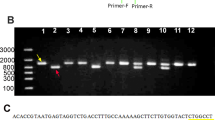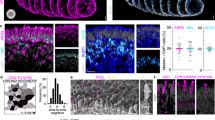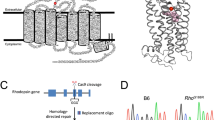Abstract
Familial exudative vitreoretinopathy (FEVR) is a hereditary ocular disorder characterized by a failure of peripheral retinal vascularization. Loci associated with FEVR map to 11q13–q23 (EVR1; OMIM 133780, ref. 1), Xp11.4 (EVR2; OMIM 305390, ref. 2) and 11p13–12 (EVR3; OMIM 605750, ref. 3). Here we have confirmed linkage to the 11q13–23 locus for autosomal dominant FEVR in one large multigenerational family and refined the disease locus to a genomic region spanning 1.55 Mb. Mutations in FZD4, encoding the putative Wnt receptor frizzled-4, segregated completely with affected individuals in the family and were detected in affected individuals from an additional unrelated family, but not in normal controls. FZD genes encode Wnt receptors, which are implicated in development and carcinogenesis. Injection of wildtype and mutated FZD4 into Xenopus laevis embryos revealed that wildtype, but not mutant, frizzled-4 activated calcium/calmodulin-dependent protein kinase II (CAMKII) and protein kinase C (PKC), components of the Wnt/Ca2+ signaling pathway. In one of the mutants, altered subcellular trafficking led to defective signaling. These findings support a function for frizzled-4 in retinal angiogenesis and establish the first association between a Wnt receptor and human disease.
This is a preview of subscription content, access via your institution
Access options
Subscribe to this journal
Receive 12 print issues and online access
$209.00 per year
only $17.42 per issue
Buy this article
- Purchase on SpringerLink
- Instant access to full article PDF
Prices may be subject to local taxes which are calculated during checkout




Similar content being viewed by others
Change history
22 August 2002
Changed Wn to Wnt and changed vasculative to vasculature
Notes
NOTE: There were two typographical errors in the AOP version of this article, which have since been corrected. On page 1, 'Wn' in line 12 was replaced with 'Wnt', and 'vasculative' in line 10 was replaced with 'vasculature'. The article will appear correctly in a forthcoming print issue.
References
Li, Y., Fuhrmann, C., Schwinger, E., Gal, A. & Laqua, H. The gene for autosomal dominant familial exudative vitreoretinopathy (Criswick-Schepens) on the long arm of chromosome 11. Am. J. Ophthalmol. 113, 712–713 (1992).
Shastry, B.S., Hejtmancik, J.F., Plager, D.A., Hartzer, M.K. & Trese, M.T. Linkage and candidate gene analysis of X-linked familial exudative vitreoretinopathy. Genomics 27, 341–344 (1995).
Downey, L.M. et al. A new locus for autosomal dominant familial exudative vitreoretinopathy maps to chromosome 11p12-13. Am. J. Hum. Genet. 68, 778–781 (2001).
Canny, C.L. & Oliver, G.L. Fluorescein angiographic findings in familial exudative vitreoretinopathy. Arch. Ophthalmol. 94, 1114–1120 (1976).
de Crecchio, G. et al. Autosomal recessive familial exudative vitreoretinopathy: evidence for genetic heterogeneity. Clin. Genet. 54, 315–320 (1998).
Kondo, H. et al. Delineation of the critical interval for the familial exudative vitreoretinopathy gene by linkage and haplotype analysis. Hum. Genet. 108, 368–375 (2001).
Muller, B. et al. Mapping of the autosomal dominant exudative vitreoretinopathy locus (EVR1) by multipoint linkage analysis in four families. Genomics 20, 317–319 (1994).
Shastry, B.S. et al. Linkage and candidate gene analysis of autosomal-dominant familial exudative vitreoretinopathy. Clin. Genet. 58, 329–332 (2000).
Bhanot, P. et al. A new member of the frizzled family from Drosophila functions as a Wingless receptor. Nature 382, 225–230 (1996).
Cadigan, K.M. & Nusse, R. Wnt signaling: a common theme in animal development. Genes Dev. 11, 3286–3305 (1997).
Hsieh, J.C., Rattner, A., Smallwood, P.M. & Nathans, J. Biochemical characterization of Wnt-frizzled interactions using a soluble, biologically active vertebrate Wnt protein. Proc. Natl Acad. Sci. USA 96, 3546–3551 (1999).
Rulifson, E.J., Wu, C.H. & Nusse, R. Pathway specificity by the bifunctional receptor frizzled is determined by affinity for wingless. Mol. Cell 6, 117–126 (2000).
Wang, Y., Huso, D., Cahill, H., Ryugo, D. & Nathans, J. Progressive cerebellar, auditory, and esophageal dysfunction caused by targeted disruption of the frizzled-4 gene. J. Neurosci. 21, 4761–4771 (2001).
Wodarz, A. & Nusse, R. Mechanisms of Wnt signaling in development. Annu. Rev. Cell Dev. Biol. 14, 59–88 (1998).
Kuhl, M., Sheldahl, L.C., Park, M., Miller, J.R. & Moon, R.T. The Wnt/Ca2+ pathway: a new vertebrate Wnt signaling pathway takes shape. Trends Genet. 16, 279–283 (2000).
Boutros, M., Paricio, N., Strutt, D.I. & Mlodzik, M. Dishevelled activates JNK and discriminates between JNK pathways in planar polarity and wingless signaling. Cell 94, 109–118 (1998).
Kuhl, M., Sheldahl, L.C., Malbon, C.C. & Moon, R.T. Ca2+/calmodulin-dependent protein kinase II is stimulated by Wnt and Frizzled homologs and promotes ventral cell fates in Xenopus. J. Biol. Chem. 275, 12701–12711 (2000).
Sheldahl, L.C., Park, M., Malbon, C.C. & Moon, R.T. Protein kinase C is differentially stimulated by Wnt and Frizzled homologs in a G-protein-dependent manner. Curr. Biol. 9, 695–698 (1999).
Korinek, V. et al. Constitutive transcriptional activation by a β-catenin-Tcf complex in APC−/− colon carcinoma. Science 275, 1784–1787 (1997).
Ishikawa, T. et al. Mouse Wnt receptor gene Fzd5 is essential for yolk sac and placental angiogenesis. Development 128, 25–33 (2001).
Monkley, S.J., Delaney, S.J., Pennisi, D.J., Christiansen, J.H. & Wainwright, B.J. Targeted disruption of the Wnt2 gene results in placentation defects. Development 122, 3343–3353 (1996).
Gong, Y. et al. LDL receptor-related protein 5 (LRP5) affects bone accrual and eye development. Cell 107, 513–523 (2001).
O'Connell, J.R. & Weeks, D.E. PedCheck: a program for identification of genotype incompatibilities in linkage analysis. Am. J. Hum. Genet. 63, 259–266 (1998).
den Dunnen, J.T. & Antonarakis, S.E. Mutation nomenclature extensions and suggestions to describe complex mutations: a discussion. Hum. Mutat. 15, 7–12 (2000).
Kaykas, A., Worringer, K. & Sugden, B. CD40 and LMP-1 both signal from lipid rafts but LMP-1 assembles a distinct, more efficient signaling complex. EMBO J. 20, 2641–2654 (2001).
Umbhauer, M. et al. The C-terminal cytoplasmic Lys-Thr-X-X-X-Trp motif in frizzled receptors mediates Wnt/β-catenin signalling. EMBO J. 19, 4944–4954 (2000).
Xie, J. et al. Activating Smoothened mutations in sporadic basal-cell carcinoma. Nature 391, 90–92 (1998).
Acknowledgements
The authors thank J. Thompson, T. Pape, J. MacFarlane, B. Payne, C. Radomski, M. Mattice, A. Hogan, P. Samra, and G. Donaldson at Xenon Genetics and C. Tatlidil at Dalhousie University for technical support; F. Mikelberg for discussion; and the members of the affected families for their enthusiasm and participation. This work was supported in part by a grant from the Nova Scotia Health Research Foundation and the IWK Health Centre to J.R. B.S.S. was supported in part by the Fight for Sight research division of Prevent Blindness America. R.T.M. is an Investigator of the Howard Hughes Medical Institute. M.R.H. holds a Canada Research Chair. A.K. was supported by an US National Institutes of Health Reproductive Biology Training Grant.
Author information
Authors and Affiliations
Corresponding author
Ethics declarations
Competing interests
Portions of this research have been financially supported by Xenon Genetics, Inc., either directly (through research collaborations) or indirectly (as some of the authors are Xenon employees).
Rights and permissions
About this article
Cite this article
Robitaille, J., MacDonald, M., Kaykas, A. et al. Mutant frizzled-4 disrupts retinal angiogenesis in familial exudative vitreoretinopathy. Nat Genet 32, 326–330 (2002). https://doi.org/10.1038/ng957
Received:
Accepted:
Published:
Issue Date:
DOI: https://doi.org/10.1038/ng957
This article is cited by
-
Mutations in TSPAN12 gene causing familial exudative vitreoretinopathy
Human Genomics (2024)
-
Kinesin-5 Eg5 is essential for spindle assembly, chromosome stability and organogenesis in development
Cell Death Discovery (2022)
-
Novel Norrie disease gene mutations in Chinese patients with familial exudative vitreoretinopathy
BMC Ophthalmology (2021)
-
Circular RNAs: Novel target of diabetic retinopathy
Reviews in Endocrine and Metabolic Disorders (2021)
-
Fenofibrate prevents iron induced activation of canonical Wnt/β-catenin and oxidative stress signaling in the retina
npj Aging and Mechanisms of Disease (2020)



